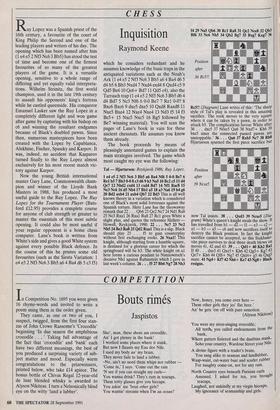CHESS
Inquisition
Raymond Keene
Ruy Lopez was a Spanish priest of the 16th century, a favourite of the court of King Philip the Second and one of the leading players and writers of his day. The opening which has been named after him (1 e4 e5 2 Nf3 Nc6 3 Bb5) has stood the test of time and become one of the firmest favourites of so many of the greatest players of the game. It is a versatile opening, sensitive to a whole range of differing and yet equally valid interpreta- tions. Wilhelm Steinitz, the first world champion, used it in the late 19th century to assault his opponents' king's fortress while he castled queenside. His conqueror Emanuel Lasker saw the Ruy Lopez in a completely different light and won game after game by capturing with his bishop on c6 and winning the resultant endgames because of Black's doubled pawns. Since then, numerous masterpieces have been created with the Lopez by Capablanca, Alekhine, Fischer, Spassky and Karpov. It was, indeed, no accident that Kasparov turned finally to the Ruy Lopez almost exclusively for his most recent match vic- tory against Karpov.
Now the young British international master Gary Lane, Commonwealth cham- pion and winner of the Lloyds Bank Masters in 1988, has produced a most useful guide to the Ruy Lopez. The Ruy Lopez for the Tournament Player (Bats- ford £12.95) provides a complete course for anyone of club strength or greater to master the. essentials of this most subtle opening. It could also be most useful if your regular opponent is a home chess computer. Lane's book is written from White's side and gives a good White system against every possible Black defence. In the course of this he prunes some old favourites (such as the Siesta Variation: 1 e4 e5 2 N13 Nc6 3 Bb5 a6 4 Ba4 d6 5 c3 f5) which he considers redundant and he assumes knowledge of the basic traps in the antiquated variations such as the Noah's Ark (1 e4 e5 2 Nf3 Nc6 3 Bb5 a6 4 Ba4 d6 5 d4 b5 6 Bb3 Nxd4 7 Nxd4 exd4 8 Qxd4 c5 9 Qd5 Be6 10 Qc6+ Bd7 11 Qd5 c4), also the Tarrasch trap (1 e4 e5 2 Nf3 Nc6 3 Bb5 d6 4 d4 Bd7 5 Nc3 Nf6 6 0-0 Be7 7 Rel 0-0? 8 Bxc6 Bxc6 9 dxe5 dxe5 10 Qxd8 Raxd8.11 NxeS Bxe4 12 Nxe4 Nxe4 13 Nd3 15 14 f3 Bc5+ 15 Nxc5 Nxc5 16 Bg5 followed by Be7 winning material). You will scan the pages of Lane's book in vain for these ancient chessnuts. He assumes you know them already.
The . book proceeds by means of pleasingly annotated games to explain the main strategies involved. The game which most caught my eye was the following: Tal — Hjartarson: Reykjavik 1986; Ruy Lopez.
1 e4 e5 2 N13 Nc6 3 Bb5 a6 Ba4 Nf6 5 0-0 Be7 6 Rel b5 71363 0-0 8 c3 d6 9 b3 Na5 10 Bc2 c5 11 d4 Qc7 12 Nbd2 cxd4 13 cxd4 Bd7 14 NH Rac8 15 Ne3 Nc6 16 d5 Nb4 17 Bbl a5 18 a3 Na6 19 b4 g6 20 Bd2 axb4 21 axb4 Qb7 22 Bd3 This is all well known theory in a variation which is considered one of Black's most solid fortresses against the Spanish torture. Here Lane has the throwaway remark that 22 . . . Qb6 23 Qe2 Nc7 24 Ndl Ra8 25 Nc3 Rxal 26 Rxal Ra8 27 Rcl gives White a slight plus, and quotes the reference Hellers Howell, Reykjavik, 1990. 22 . . . Nc7 23 Nc2 Nh5 24 Be3 Ra8 25 Qd2 Rxal This is a slip. Black should play 25 . . . f5 to gain counterplay without first exchanging rooks. 26 Nxal! This knight, although starting from a humble square, is destined for a glorious career for which the springboard will be b3. The white knight on al here forms a curious pendant to Nimzowitsch's decisive Nhl against Rubinstein which I gave in last week's column. 26 . . f5 27 Bh6 Ng7 28 Nb3
f4 29 Na5 Qb6 30 Rd Ra8 31 Qc2 NceS 32 Qb3 Bf6 33 Nc6 Nh5 34 Qb2 13g7 35 Bxg7 Kxg7 36 Position after 36 Rc5!!
Rc5!! (Diagram) Lane writes of this: 'The sharp style of Tal's play is revealed in this amazing sacrifice. The rook moves to the very square where it can be taken by a pawn, in order to attack b5. The complications favour White after 36 . . . dxc5 37 Nfxe5 Qa6 38 Nxd7+ Kh6 39 bxc5 since the connected passed pawns are unstoppable.' 36 . . Qa6 37 Rxb5 Nc7 38 Rb8 Hjartarson spurned the first piece sacrifice but
Position after 39 Ncxe5
now Tal ins'sts. 38 . . . Qxd3 39 Ncxe5 (11a- gram) White's queen's knight steals the show. It has travelled from bl — d2 — fl — e3 — c2 — at — b3 — a5 — c6 and now sacrifices itself to destroy the Black position. In fact the knight sacrifice cannot be accepted, so this Stakhano- vite piece survives to deal three death blows on moves 41, 42 and 43. 39 . . . Qdl+ 40 KU Ra1 If 40 . . . dxe5 41 Qxe5+ Kh6 42 Qg5+ Kg7 43, Qe7+ Kh6 44 Qf8+ Ng7 45 Qxf4+ g5 46 Qxg3 mate. 41 Ng4+ Kf7 42 Nh6+ Ke7 43 Ng8+ Black resigns.


































































 Previous page
Previous page